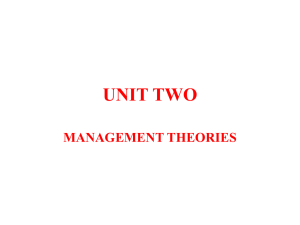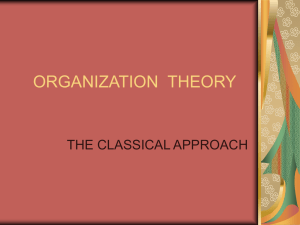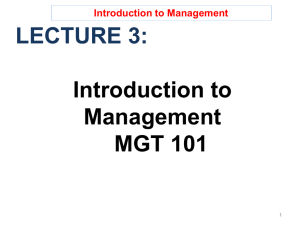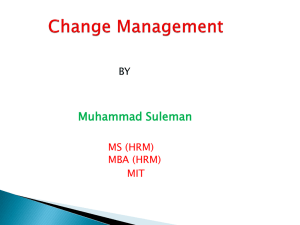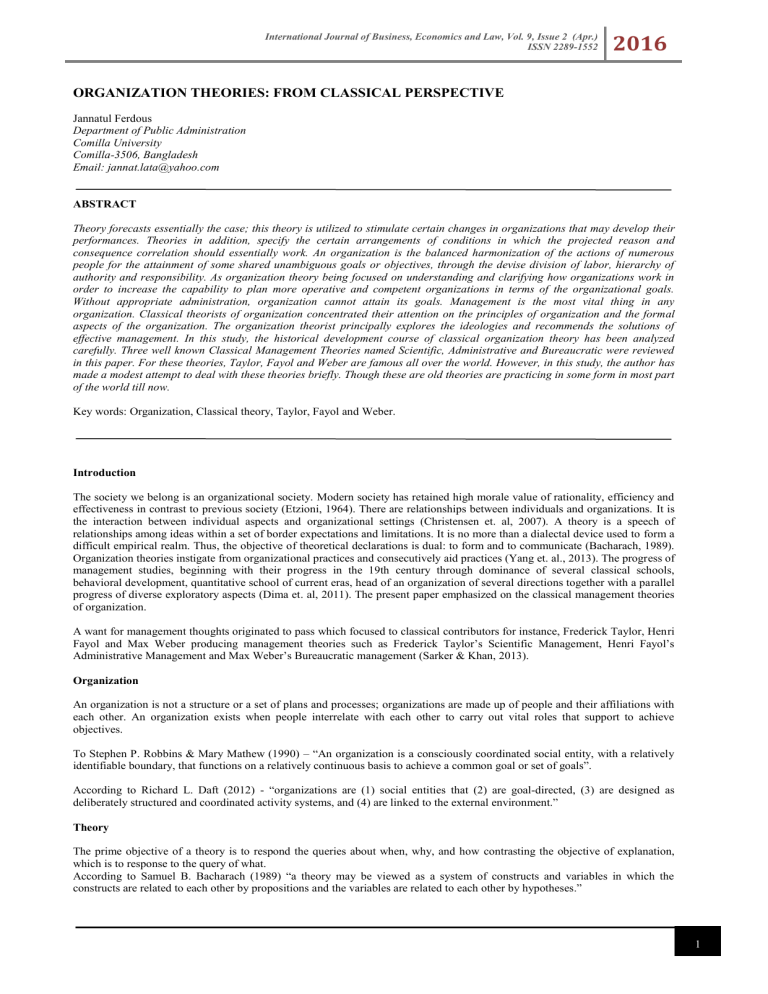
International Journal of Business, Economics and Law, Vol. 9, Issue 2 (Apr.) ISSN 2289-1552 2016 ORGANIZATION THEORIES: FROM CLASSICAL PERSPECTIVE Jannatul Ferdous Department of Public Administration Comilla University Comilla-3506, Bangladesh Email: jannat.lata@yahoo.com ABSTRACT Theory forecasts essentially the case; this theory is utilized to stimulate certain changes in organizations that may develop their performances. Theories in addition, specify the certain arrangements of conditions in which the projected reason and consequence correlation should essentially work. An organization is the balanced harmonization of the actions of numerous people for the attainment of some shared unambiguous goals or objectives, through the devise division of labor, hierarchy of authority and responsibility. As organization theory being focused on understanding and clarifying how organizations work in order to increase the capability to plan more operative and competent organizations in terms of the organizational goals. Without appropriate administration, organization cannot attain its goals. Management is the most vital thing in any organization. Classical theorists of organization concentrated their attention on the principles of organization and the formal aspects of the organization. The organization theorist principally explores the ideologies and recommends the solutions of effective management. In this study, the historical development course of classical organization theory has been analyzed carefully. Three well known Classical Management Theories named Scientific, Administrative and Bureaucratic were reviewed in this paper. For these theories, Taylor, Fayol and Weber are famous all over the world. However, in this study, the author has made a modest attempt to deal with these theories briefly. Though these are old theories are practicing in some form in most part of the world till now. Key words: Organization, Classical theory, Taylor, Fayol and Weber. Introduction The society we belong is an organizational society. Modern society has retained high morale value of rationality, efficiency and effectiveness in contrast to previous society (Etzioni, 1964). There are relationships between individuals and organizations. It is the interaction between individual aspects and organizational settings (Christensen et. al, 2007). A theory is a speech of relationships among ideas within a set of border expectations and limitations. It is no more than a dialectal device used to form a difficult empirical realm. Thus, the objective of theoretical declarations is dual: to form and to communicate (Bacharach, 1989). Organization theories instigate from organizational practices and consecutively aid practices (Yang et. al., 2013). The progress of management studies, beginning with their progress in the 19th century through dominance of several classical schools, behavioral development, quantitative school of current eras, head of an organization of several directions together with a parallel progress of diverse exploratory aspects (Dima et. al, 2011). The present paper emphasized on the classical management theories of organization. A want for management thoughts originated to pass which focused to classical contributors for instance, Frederick Taylor, Henri Fayol and Max Weber producing management theories such as Frederick Taylor’s Scientific Management, Henri Fayol’s Administrative Management and Max Weber’s Bureaucratic management (Sarker & Khan, 2013). Organization An organization is not a structure or a set of plans and processes; organizations are made up of people and their affiliations with each other. An organization exists when people interrelate with each other to carry out vital roles that support to achieve objectives. To Stephen P. Robbins & Mary Mathew (1990) – “An organization is a consciously coordinated social entity, with a relatively identifiable boundary, that functions on a relatively continuous basis to achieve a common goal or set of goals”. According to Richard L. Daft (2012) - “organizations are (1) social entities that (2) are goal-directed, (3) are designed as deliberately structured and coordinated activity systems, and (4) are linked to the external environment.” Theory The prime objective of a theory is to respond the queries about when, why, and how contrasting the objective of explanation, which is to response to the query of what. According to Samuel B. Bacharach (1989) “a theory may be viewed as a system of constructs and variables in which the constructs are related to each other by propositions and the variables are related to each other by hypotheses.” 1 International Journal of Business, Economics and Law, Vol. 9, Issue 2 (Apr.) ISSN 2289-1552 2016 According to John McAuley, Joanne Duberley and Phil Johnson (2007) “Theories propose reasons in the form of cause-andeffect relationships that explain the variation of a particular phenomenon in terms of the effects of the action of, or the variation in, another phenomenon – the why and the how.” Organizational Theory Organizational theories have been engaged with the formation of overall ideas and approaches that are appropriate to any organization, regardless of its societal, activities and geographical surroundings (Irefin & Bwala, 2012). Organizational theory proceeds by way of its main item of study, the formal or complex organization. It is presumed that organizations have objectives, guidelines, hierarchy, definitions of affiliation, and vigorous ideas of career tracks for their affiliates. Organizational theory is worried with in what way the core organizational arrangement works to inspire members and yield results constant with the objectives of those who regulate the organization. It is as well involved in how the external world to an organization impacts what drives on inside of a specific organization. Lastly, it is anxious with how the core organization and the external sphere can influence organizational existence (Fligstein, 2001). Classical Organization Theory The studies made by the classical scholars of organization concentrated their devotion upon the laying down of the organizational ideologies and upon the official features of the organization. The organization scholar mostly examines into the philosophies and recommends the clarifications to be taken into concern by the heads such as the instructions confirming an effective management. Through the classical scholar of organization we can see very few experiments and administrative observation for trying the viability of the philosophies and propositions projected (Ivanko, 2012). Theories of Management can be classified as Theories of Classical Management, Theories of Humanistic Management, Theories of Situational Management and Theories of Modern Management, etc. Among all kinds of Management Theories, Classical Management Theories are very significant as they deliver the source for all other concepts of management (Mahmood et al, 2012). The classical theory is distributed into three modules: Scientific Management, Administrative Management and Bureaucratic management (Sofi, 2013). Frederick Taylor, Henri Fayol and Max Weber created the structure and the improvement frame of Classical Organization Theories (Yang et al., 2013). The scientific management approach developed by Taylor is based on the concept of planning of work to achieve efficiency, standardization, specialization and simplification. Taylor was the first person who attempted to study human behavior at work using a systematic approach. Max Weber considered the organization as a segment of broader society. He looked at the structure of the organization and the control of member behavior. The elements of administrative structure by Fayol relate to the accomplishment of tasks, and include principles of management, the concept of line and staff, committees and function of management (Irefin & Bwala, 2012). Figure 1: Three Modules of Classical Organization Theory Scientific Mnagement (Frederick Taylor) Administrative Management (Heri Fayol) Bureaucratic Management (Max Weber) Scientific Management Frederick W. Taylor (1856-1915) is generally known as the father of scientific management for of the impact of his famous contribution (Sarker & Khan, 2013). Frederick Taylor initiated the period of modern management. In the later part of the nineteenth and initial stage of the twentieth centuries, he was criticizing the “uncooperative, unproductive, or ill-focused activities of men” as state loss. Taylor reliably wanted to take over management “by rule of thumb” and switch it with definite timed clarifications leading to “the one best” exercise. Moreover, he encouraged the organized training of workforces in “the one best practice” rather than sanctioning them particular preference in their responsibilities. Additionally, he assumed that the assignment would be consistently pooled concerning the workforces and management by means of management, acting the science and tutoring and the workforces performing the labor, every group performing “the task for which it was well-matched” 2 International Journal of Business, Economics and Law, Vol. 9, Issue 2 (Apr.) ISSN 2289-1552 2016 (Olum, 2004). To raise proficiency, he has presented four principles in his Scientific Management Theory. Moreover, he forecasts that these principles are appropriate to all types of human deeds, from a simple deed of individual to the complex tasks of organization (Mahmood et. al, 2012). Taylor’s Four Principles of Scientific Management Taylor observes management as the procedure of getting things done by the effort of the people working independently or in sets. Taylor’s core idea is that affluence to the society can come simply from the cooperative effort of the management and worker in the use of scientific methods. He emphasized for mental revolution on both the part of management and labor side, thus that they may work together in the essence of work coordination with a vision to cultivating their particular lots achieving high pays for labor and better output at little expenses for management. Taylor perceives that management is ignoring its tasks, and force the liability of systems and production on labor. He asserts that management should commit to do the planning of work, defining methods, organizing, directing and the like for which it is finest fit (Sapru, 2008). Taylor explains on his theories of management in 1911, while he circulated “The Principles of Scientific Management”. Taylor stated Scientific management comprised of four fundamental principles in the “The Principles of Scientific Management” (1911) as: 1) Replace the old rule-of-thumb method through the development of a science for every component of a man’s work. 2) Select, train, show and improve the workman through scientific method. 3) Collaboration with men wholeheartedly so as to complete the assignment scientifically. 4) Equally divide the work and the responsibility concerning the management and the worker. The management gets all determination for which they are fine fitted than the workmen. In review, Taylor presented an inadequate attention to organizations. He was considered merely at organizing effort at the bottom level of the organization that are suitable to the management work of a manager (Robbins & Mathew, 1990). Scientific management transformed business because it describes how to raise production by functioning smoother, not tougher. Up until that time, growing output intended more employees, more raw materials, more hours, and more expenses. Scientific management practices simple sense to express how division of labor, standardization, and productivity, emphasized an image of effectiveness that booms currently (Adeyemi et. al, n.d.). Therefore, Scientific Management, in general has taken a significant and extensive influence on the business exercise and on the theoretical concepts of organizations. Yet, it still works as a guide for methodological dealings, not simply in the industrial sector, but in the service sector as well. Administrative Management Henri Fayol (1841-1925), was a director of mines and French engineer. He was slight recognized outside France till the late 1940s, when published Constance Storrs her translation of Fayol's 1916 Administration Industrielle ET Generale. This monograph was published in 1916 after his retirement, required to produce his managerial practices and acquaintance. His theorizing about administration was constructed on personal reflection and involvement of what functioned sound in the organizations with which he was familiar (McNamara, 2009). He settled this theory on his own understanding and practice. This theory is about business management along with overall management. Its key attention is management. He offered six functions and fourteen principles of management in his theory. Key six functions of management are such as below: i) Forecasting ii) Planning iii) Organizing iv) Commanding v) Coordinating vi) Monitoring (Mahmood et. al, 2012). Fayol well-known administrative capability was vital for the success of the organization. Administrative capability, according to Fayol, rests on definite talents and understanding: a) Physical qualities b) Mental qualities c) Moral qualities d) General education e) Special knowledge and f) Experience (Wren & Bedeian, 1994). Principles of Management Fayol’s “14 Principles” of management was one of the initial theories of management to be shaped, and has endured one of the most wide-ranging. Alika & Aibieyi (2014) summarized the “14 Principles of Management by Fayol” are itemized below: 1. Division of Work: Productivity would rise as the employees develop gradually expert and competent on the job, when workforces are specialized. 2. Authority: Managers have the essential authority to give commands, however, they must as well remember that responsibility comes with authority, in arguments, take responsibility for all events carried out within the organization. 3. Discipline: Discipline need to be maintained at all times, but the approaches should be defined, because discipline differs from one organization to another organization. 4. Unity of Command: Employees must have simply one direct supervisor as no man can attend two bosses at the same time. 5. Unity of Direction: Teams with the similar objective must be functioning under the direction of single manager through expending one plan. This will confirm that action is well organized. 6. Subordination of Individual Interests to the General Interest: The interests of single employee would not be accepted to become more significant than those of the set. This contains managers also. 7. Remuneration: Satisfaction of employees rest on on fair remuneration for every employee. This contains monetary and nonmonetary return. 3 International Journal of Business, Economics and Law, Vol. 9, Issue 2 (Apr.) ISSN 2289-1552 2016 8. Centralization: This principle denotes to in what way employees are close to the decision-making procedure. It is significant to aim for a proper balance. 9. Scalar Chain: Employees must be conscious of where they located in the hierarchy of organizations, or its chain of command. 10. Order: The facilities of the workstation require being fresh, neat and harmless for employees. The whole thing must have its place. 11. Equity: At all times, managers must be impartial to employees, equally in the matter of in preserving discipline as essential and working with sympathy where suitable. 12. Stability of Tenure of Personnel: Managers must take attempt to reduce employee turnover. Planning for maintaining personnel must be a main concern for the organization. 13. Initiative: Employees must be allowed to maintain the independence to generate and fulfill strategies. 14. Esprit de Corps: Organizations must struggle to stimulate a team spirit and harmony always. His concrete list of principles assisted initial period of the 20th century managers study how to institute and cooperate with their personnel in a dynamic way. Several of the principles are currently measured as common sense, however, at the time they were groundbreaking ideas for organizational management. 14 principles still now provide direction for the present day’s managers. Bureaucratic Management Max Weber (1864-1920), who initiated the contemporary sociological study of bureaucracy, freed the word from pejorative connotations, and stressed the essentiality of bureaucracy for the rational achievement of the aims of the organizations. Weber named his creation as “ideal type”, an ideal type is what attempts selected by an organization (Mili & Nasrullah, 2014). He argued about three ideal types of authority with the purpose of finding out why in a hierarchical arrangement or organization an individual accepts by the instructions of his/her boss (Khan, 2013). Weber’ uttered diverse views of authority: • Traditional authority: Centered on the traditionally shaped legitimacy where authority is inherited and grounded on dependent subordinates. • Rational-Legal authority: The bureaucratic type of authority, grounded on normative procedures for job, chain of command etc. • Charismatic authority: The particular authority, constructed on a type of ‘seduction’ and therefore, the dedication of followers (Lægaard & Bindslev, 2006). Characteristics of Bureaucracy Weber settled the rational-legal ideal type bureaucracy to clarify its important structures. Following are the characteristics of bureaucracy summarized by Naidu (1996) as described by Weber: 1. Bureaucratic offices are structured hierarchically; that is, every lower office is in the supervision and control of a greater one. 2. Every office has an evidently demarcated range of action in the legitimate logic. 3. Bureaucrats are selected on the source of strict qualifications as resolute by certificates or competitive examinations. 4. The bureaucrats are selected, not elected, on the source of an open agreement. The official bureaucrats are allowed to resign always. 5. The bureaucrats accept fixed remunerations in money permitting to rank in the hierarchy of the organization. For the utmost part they have a right to retirement pension. 6. The work is the one and only, or at least the key job of the bureaucrats. 7. There is a career progress structure wherein promotions are centered on merit and/or seniority promotion is relying on the decision of the superior. 8. The bureaucrats do not specify his or her office and the resources of the administration. He cannot apt his position. 9. The bureaucrats are matter of firm and orderly discipline and regulate in the behavior of the office. 10. The staffs of a bureaucratic body are individually unrestricted and subject to authority merely with respect to their impersonal formal responsibilities. Weber’s exploration has been massively significant. He recognized the big organization as the new approach to organize. He assumed that it was most proficient and he was capable to ground its acceptability in his broader theory of the world and organizations (Fligstein, 2001). Still, this theory is in practice. Late theories of management have taken benefits from this theory. It expresses that this theory has great role in account of management theories. Still Appealing First organized studies in the arena of management are accompanied by Taylor. As Taylor made an effort to show grounds behind workers’ methodologies and the objective aimed when management gets the decision in the written system and investigation. Taylor’s studies followed by Fayol. Fayol stretches a slight more significance to the human aspect and has drawn responsiveness to workers’ influence on production. Yet, Weber has stated the bureaucratic side of management by measuring science of management from a diverse perspective. Weber’s stressed that bureaucracy is vital in management and that everyone must accomplish his responsibilities in a hierarchic arrangement (Celik & Dogan, 2011). Classical method has been evaluated on some grounds. First, this theory is thought to be excessively formal; secondly, it is more applicable for a constant and simple form of organization than for current complex and vibrant organizations. Thirdly, it frequently recommended the universal measures that are not suitable in diverse setting (Sarker & Khan, 2013). Though these denunciations, modern tactics, in any case, bonds all these cases, and plays a vital role in management’s coming to its currently used system. 4 International Journal of Business, Economics and Law, Vol. 9, Issue 2 (Apr.) ISSN 2289-1552 2016 Taylor laid out the procedure of scientifically studying effort to raise workers and organizational productivity in The Principles of Scientific Management (Giannantonio & Hurley-Hanson, 2011). The first principle delivered by Taylor gained popularity as we are in an era of factory automation where the promptness of the production line is determined by mechanical concerns mainly, there are several cases where responsibilities accepted by workers are improved by a scientific method. The second principle is a utmost applicable principle at the present day as much effort is placed on employing the right person for a place. During interviews, the use of psychologists to decide a candidate’s fittings is one mutual use of “science” for selection. When an appropriate employee is found, several firms make practice of training programmes to constantly improve employees’ abilities. Currently, the third principle can be perceived in the practice of human relations. The last principle is grounded on isolating up the work in an organization into two big modules, one for management and one for the workers. This rise in responsibility on the side of the management can be seen as adopting the necessity for the four management roles, viz. leading, planning, controlling and organizing. In affecting beyond the four principles, sign can be found that scientific management is traditionally significant to the progress of modern business and, simultaneously appropriate still (McKinnon, 2003). In recent management research, certain of the principles have been reshaped and re-construed to become well and more operative to organizations in their use. However a few others have continued as Fayol assumed them and is extensively accepted still in the management of current organizations. Usually, all organizations are comparable in some means in the framework of management as an exercise (Uzuegbu & Nnadozie, 2015). Today within the 14 principles of Fayol, still most organizations exercise the principles, acknowledged by Fayol as it summarizes individual work and team forces at work, however, there is less exercise of the ‘unity of command’ as most of the workforce incline to report to more than one supervisor nowadays (Adegboye, 2013). The use of these principles must be flexible adequate to match each particular organizational state. Yet, successively, the inflexible application of these tasks by managers came in criticism. However the point rests that his argument that management is a constant procedure starting with planning and termination with controlling remains popular as well today and can be seen in all management writings practically (Haque, 2007). Weber has stated the bureaucracy from the perspective of management by measuring science of management from a diverse angle. Weber’s stressed that bureaucracy is significant in management and that everyone requires carrying out his responsibilities in a hierarchic arrangement. Besides, modern approaches unite all these studies and plays a vital role in management’s approaching to its present used form (Celik & Dogan, 2011). Well ahead theories of management have taken benefits from this theory. Ideal bureaucracy, paperwork, written rules, discipline and reward method, training of workers and managers are part of practically all the organization of the realm. It indicates that this theory has large role in the past of management theories. The major principle of bureaucracy is written work. Other vital principles are the authority of manager check and balance system, written rules, and reward system. Still, Bureaucracy is in practice in the larger organization of the world (Mahmood & Bashir, 2012). Presently, in modern societies Bureaucracies have become principally persistent, and consequently just have shown a noteworthy point of thought regarding their presence. The contemporary capitalist country is entirely reliant on bureaucratic organization for its sustainable presence. Conclusion Fruitful management needs an understanding of the ultimate conceptions of real management skills and philosophies. With the intention of gaining such comprehension, and cope successfully and proficiently, managers must grow consciousness of previous management philosophies, representations and principles. The necessity for a formal management theory was increasing significantly since the turn of the 19th Century, that organization essentially an arrangement to guide managers in an effort to increase efficiency and productivity of workforces. Theory of Classical management is a set of comparable philosophies on the management of the organization that developed in the later part of the 19th and the starting of the 20th centuries. As specified earlier in the paper Scientific, Administrative and Bureaucratic are offered as the three key categories under classical theory. The major and common features of all the three divisions are they stressed the financial reasonableness of organization and the management. The key influence of the classical school of management comprises relating science in everyday management, increasing basic management function and processes, and determining the application of specific principles of the concept of management. Yet, the classical theory is evaluated as out-of-date and has become history, still this is the principal school of management thought of organization and the most predominant kind of management seen in today’s business arrangements in practice even though they do not in real terms reflect universal use and appeal. References Adegboye, M. (2013). The applicability of management theories in Nigeria: exploring the cultural challenge. International Journal of Business and Social Science, 4(10). Adeyemi, A. A., Aslam, E., Cohen, A., Singh, S., & Soltis, J. (n. d. ). An Analytical Study On Scientific Management. Alika, I. J., & Aibieyi, S. (2014). Human capital: Definitions, approaches and management dynamics. Journal of Business Administration and Education, 5 (1), 55. Bacharach, S. B. (1989). Organizational theories: Some criteria for evaluation. Academy of management review, 14 (4), 496515. Celik, M., & Dogan, E. (2011). A Theoretical Approach to the Science of Management. International Journal of Humanities and Social Scienc, 1 (3). 5 International Journal of Business, Economics and Law, Vol. 9, Issue 2 (Apr.) ISSN 2289-1552 2016 Christensen, T., Lægreid, P., Roness, P. G., & Røvik, K. A. (2007). Organization theory and the public sector: Instrument, culture and myth. Routledge. Daft, R. (2012). Organization theory and design. Nelson Education. Dima, I. C., Vokorokosova, R., Pachura, P., & Sandu, M. (2011). Integration Process in Management Science-Theoretical Review. Annals of the University of Petroşani, Economics, 11 (1), 71-76 Etzioni, A. (1964). Modern organizations. New Jersey: Prentice-Hall Inc. Fligstein, N. (2001). Organizations: Theoretical Debates and the Scope of Organizational Theory, Department of Sociology. University of California, Berkeley. Giannantonio, C. M., & Hurley-Hanson, A. E. (2011). Frederick Winslow Taylor: reflections on the relevance of the principles of scientific management 100 years later. Haque, M. M. (2007). The ABC of Management: Teach Yourself. Dhaka: AH Development Publishing House. Ivanko, Š. (2012). Modern Theory of Organization. Irefin, M. P., & Bwala, D. (2012). Organizational Theories and Analysis: A Feminist Perspective. International Journal of Advancements in Research & Technology, 1(1), 71-97. Khan, M. M. (2013). Bureaucracy in Bangladesh: A Reformist Perspective. Dhaka: BRAC University Press. Lægaard, J., & Bindslev, M. (2006). Organizational Theory. Mahmood, Z., Basharat, M., & Bashir, Z. (2012). Review of classical management theories. International Journal of Social Sciences and Education, 2(1), 512-522. McKinnon, A. (2003). The impact of scientific management on contemporary New Zealand business. McNamara, D. E. (2009). From Fayol’s Mechanistic To Today’s Organic Functions Of Management. American Journal of Business Education (AJBE), 2(1). Mili, B. R. & Nasrullah, A. M. (2014). Fundamentals of Public Administration. Dhaka: Bangladesh Institute of Islamic Thought. Naidu, S. P. (1996). Public Administration: Concepts and Theories. Delhi: New Age International Publishers. Olum, Y. (2004). Modern management theories and practices. Uganda: Makerere University. Robbins, S. P. & Mathew, M. (1990). Organization Theory: Structure, Design and Applications. Prentice Hall. Sapru, R. K. (2008). Administrative Theories and Management Practices. New Delhi: PHI Learning Private Limited. Sarker, S. I., & Khan, M. R. (2013). Classical and neoclassical approaches of management: An overview. IOSR Journal of Business and Management, 14 (6). Sofi, S. A. (2013). The Changing Concept of Management. National Monthly Refereed Journal of Research in Commerce & Management,2 (4), 157-164. Taylor, F. W. (1911). The Principles of Scientific Management. New York: Harper & Brothers. Uzuegbu, C. P., & Nnadozie, C. O. (2015). Henry Fayol’s 14 Principles of Management: Implications for Libraries and Information Centres. Journal of Information Science Theory and Practice, 3 (2), 58-72. Wren, D. A., & Bedeian, A. G. (1994). The evolution of management thought. United States of America: John Wiley & Sons, Inc. Yang, C. X., Liu, H. M., & Wang, X. X. (2013). Organization Theories: From Classical to Modern. Journal of Applied Sciences, 13 (21), 4470. 6
